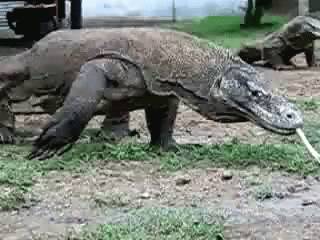
Few creatures on Earth inspire wonder the way a Komodo dragon does. The largest lizards in the world, they can be ten feet long, and their fierce appearance and hunting skills are awe-inspiring, to say the least.
They look a bit like a dragon or even a mini-dinosaur, but their looks are not the strangest thing about these animals. Komodo dragons, as it turns out, are pretty bizarre.

They’re capable of virgin births.
Komodo dragons are able to reproduce both sexually and asexually. Female Komodo dragons can fertilize their eggs with males, but in the absence of males, they can reproduce without having sex in a process called “parthenogenesis.” Asexually, they can only produce males, which — brace yourself —would presumably mate with their mother to allow the species to survive. Parthenogenesis is uncommon in large animals and more typical of invertebrates or plants.
There’s a reason why they’re so big.
Scientists believe their large size is caused by a strange phenomenon known as “island gigantism.” Animals that live in an isolated setting can become dramatically larger than their relatives, an evolutionary trend related to the absence of larger predators. Komodo dragons in the wild only number about 6,000, and they all reside on secluded Indonesian islands.

They’re fast.
Like most apex predators, the Komodo dragon is fast. Despite their armored spines and chunky legs, they can run at incredibly high speed, up to 13 mph, for short bursts of time. They don’t rely on speed for hunting, though, instead waiting stealthily for their prey. The average running speed for a human (and yes, Komodo dragons will prey upon a human) is just 8 mph.

They smell with their tongues, not their nostrils.
Another odd trait is that they smell with their forked tongues — and their sense of smell is uncanny. They’ve got nostrils, but that’s not how they sniff out their prey. Using their tongues to smell, they can detect carrion up to nearly 6 miles away. Komodo dragons also have surprisingly keen vision, and can see objects as far away as 985 feet.

They kill their prey with venom, not bacteria.
Komodo dragons don’t actually kill their prey with bacteria as we once thought. Instead, researchers have found that they inject their victims with venom from multiple ducts located between their teeth. The venom incapacitates the prey by reducing its blood pressure, expediting blood loss, and eventually sends it into shock.
National Geographic News explained, “Rather than injecting venom directly via a forceful bite, the dragons use a specialized bite-and-pull motion to ooze the toxin into wounds during a sustained, frenzied attack.”

They can eat whole animals — even those as large as a goat.
Komodo dragons generally eat by tearing off chunks of flesh from the victim, but they can also swallow animals whole. They can do this using their loosely articulated jaws, their flexible skulls, and their expandable stomach.
Swallowing large animals generally takes 15 to 20 minutes, and the animals must bask in the sun to speed up digestion. Due to their slow metabolism, komodos can survive on as little as 12 meals per year.

The babies run away after hatching so their mothers can’t eat them.
And the creepiest thing about these ancient-looking creatures? They actually eat their own young. Females incubate their clutches of eggs for about three months, and even build decoy nests to keep their unborn babies safe from predators. But once they’ve hatched, those maternal instincts melt away.
Baby komodo dragons claw their way up the trees to escape the mothers and other mature dragons who will eat them. The young Komodo dragons are excellent at using their claws to climb trees, but the older ones are less nimble. The young don’t come down from their treetop sanctuary until they are four years old and about four feet long.

Featured image via Tambako the Jaguar on Flickr




